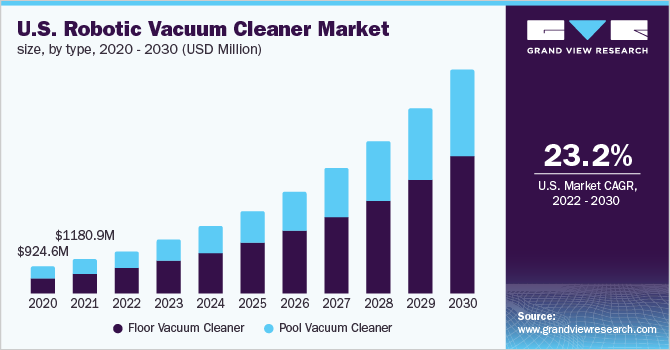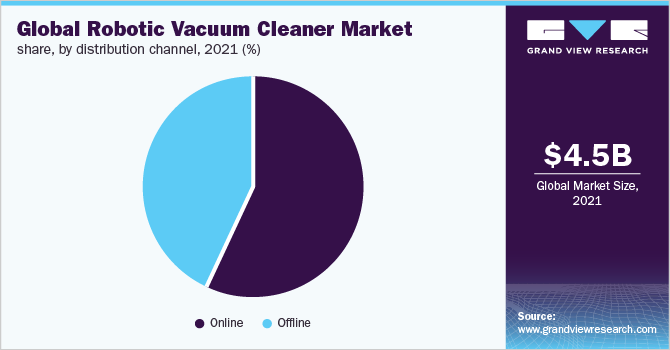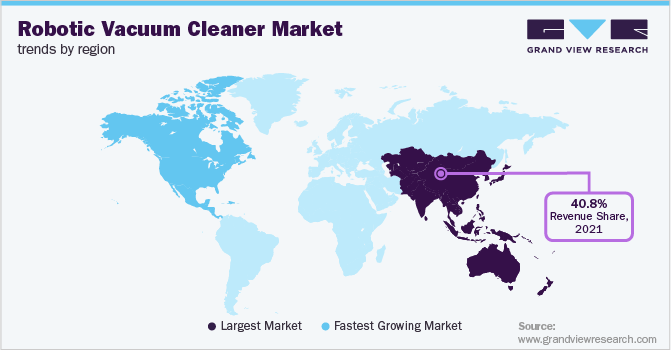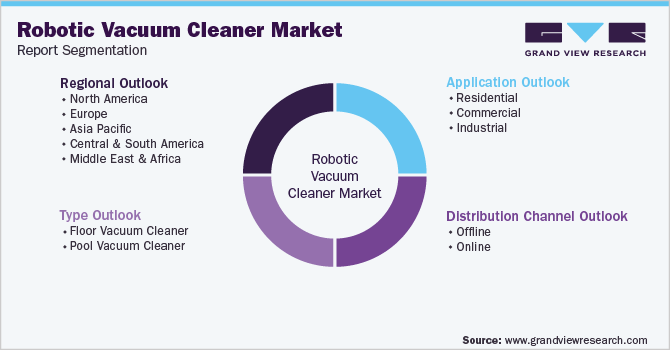
Robotic Vacuum Cleaner Market Size, Share & Trends Analysis Report By Type (Floor Vacuum Cleaner, Pool Vacuum Cleaner), By Application (Residential, Commercial, Industrial), By Distribution Channel, By Region, And Segment Forecasts, 2022 - 2030
- Report ID: GVR-4-68038-742-1
- Number of Report Pages: 80
- Format: PDF, Horizon Databook
- Historical Range: 2017 - 2020
- Forecast Period: 2022 - 2030
- Industry: Consumer Goods
Report Overview
The global robotic vacuum cleaner market size was valued at USD 4.48 billion in 2021 and is estimated to grow at a compound annual growth rate (CAGR) of 23.4% from 2022 to 2030. The adoption remains robust as the technology saves significant time and energy which is one of the primary factors driving demand for robotic vacuum cleaners. The shifting lifestyle, high disposable income, rising population of working consumers, increasing purchasing power, and ease of usage are the major factors acting as a catalyst for the growth of the market worldwide.

A rise in the adoption of vacuum cleaners has been observed due to COVID-19. The usage and adoption of robotic vacuum cleaners in various premises to disinfect the premises, and to reduce the exposure of humans to this contagious virus. The surge of COVID-19 imposed various restrictions and guidelines. Consequently, it increased the demand for cleaning workers and also gave rise to the increased usage of robotic vacuum cleaners. This technology proved ideal for disinfection and thorough cleaning.
Robotic vacuum cleaners ensure the efficient cleaning of any work or living space in a hassle-free and automated way. The spread of COVID-19 changed the preference of consumers and created new opportunities for the market. Initially, the production of robotic vacuum cleaners decreased; however, overall healthy growth has been observed in the robotic vacuum cleaner market.
Due to the ability of robotic vacuum cleaners to work without any human intervention, the consumers are more inclined to buy them. Some of the robots can charge themselves automatically by maneuvering toward the charging point and restarting operations from the point of discharge. Virtual boundaries can also be set for these robots which enable entry restrictions in undesirable areas such as the children's playroom. Thus, the aforementioned factors continue to increase the adoption of robotic vacuum cleaners, thus, propelling the market growth.
An autonomous vacuum cleaner consists of a limited vacuum cleaning system. This is known as a robotic vacuum cleaner, sometimes also known as Robovac. These vacuum cleaners are integrated with robotic drives and sensors along with programmable cleaning routines and controllers which help control the robot accordingly. The increasing inclination of consumers toward smart homes and smart home technology promises to propel market growth over the forecast period. Moreover, the increased concerns regarding hygiene and cleanliness are further anticipated to drive the adoption of robotic vacuum cleaners in the coming years.
Integration of advanced technologies such as voice assistance, and artificial intelligence continues to boost its demand among the targeted consumers. Furthermore, the growing preference of consumers toward more innovative and advanced technology integrated into robotic vacuum cleaners is expected to present key opportunities for the market. However, the short battery life along with the high charge time required for robotic vacuum cleaners make it difficult to complete the process of cleaning. In addition, robotic vacuum cleaner consumes more time for cleaning than traditional which are some factors expected to restrain the market growth over the forecast period.
Furthermore, the maintenance of robotic vacuum cleaners can be a relatively costly affair. As it consists of sensors, which is another factor anticipated to hinder market growth. The high cost of the products acts as a major challenge for the market. It restricts the adoption of the product for a mass user base. Moreover, the availability of various counterfeit products in the market acts as a major restraint for the robotic vacuum cleaner market.
Type Insights
In terms of revenue, the floor vacuum cleaner type dominated the market with a share of 60.7% in 2021 and is expected to witness the fastest growth over the forecast period with a CAGR of 23.7% from 2022 to 2030. Consumers in the market are more inclined towards the purchase of floor vacuum cleaners owing to their ability to be used on various surfaces, such as wooden floors, marble, vinyl, and tiles flooring.
Most of the daily routine of household cleaning focuses on cleaning floors, and hence the demand for floor vacuum cleaners is on the rise. The dominance and high growth of the segment can also be attributed to its efficiency to remove even the smallest of particles that may cause health issues along with its cost-efficiency.
The pool vacuum cleaner category is expected to expand at a considerable CAGR of 23.1% from 2022 to 2030. Consumers in the market are more inclined toward the purchase of pool vacuum cleaners as their brushing system helps remove debris. It also helps in removing algae and bacteria from both walls and floors. Moreover, these automatic robotic pool cleaners map the surface of the pool using advanced computer technology.
Furthermore, these clean the pool in a quick and comparatively efficient manner. In addition, robotic pool vacuum cleaners are being used widely as they come with an independent filtration system that can be emptied once full and does not require connection to the filtration system of the pool.
Application Insights
Based on revenue, the residential segment dominated the market. It held a share of 46.7% in 2021. The residential segment is further expected to grow at the fastest CAGR of 23.9% over the forecast period from 2022 to 2030. The dominance of the segment is attributed to growth in the number of smart homes and the increasing trend of smart homes across the globe.
The growth of the segment can also be attributed to the increasing adoption of automated products for daily use to minimize human intervention. Robotic vacuum cleaners are also being widely adopted due to various factors including small sizes, low- maintenance, and easily accessible spaces under cabinets, beds, tables, and others. Thus due to some of the above-mentioned factors, the segment is expected to generate more revenue.
The commercial segment is expected to grow at a substantial CAGR of 23.3% over the forecast period from 2022 to 2030. The growth of the segment is attributed to its growth in the sector due to its efficiency and speed coupled with its increased accuracy due to the integration of continuously advancing technology.
Moreover, the demand and requirement for cleaning commercial places without the involvement of the human workforce has emerged due to COVID-19 which also boosted the adoption of robotic vacuum cleaners. Majorly, the demand and adoption were observed in the hospital segment to maintain cleanliness and hygiene and control the spread of COVID-19 thus contributing to the segment growth.
Distribution Channel Insights
On the basis of distribution, the online channel segment held the largest share of 56.5% in 2021 and is expected to expand at the fastest CAGR of 23.7% from 2022 to 2030. An increase in social media marketing supports the growth of online distribution channels. Online channels provide features such as easy return, price comparison, and availability of diverse product range which results in a shift of consumer preference towards online channels. The preference of consumers with bounded time is towards multi-brand online retailers as they aid them to select robotic vacuum cleaners from various providers. Rising direct-to-consumer offerings also act as a catalyst for the growth of the online segment.

The offline distribution channel is expected to grow with a substantial CAGR of 23.1% over the forecast period. This is attributed to the rising number of electronics and appliance specialty stores, resulting in increasing shelf space for the marketing of products. Consumers purchase robotic vacuum cleaners from offline stores to find the right fit and understand the mechanism and functionality of the robotic vacuum cleaner. Moreover, many retailers in the market have sales representatives to offer the right product as per consumers’ needs and consumers can get a demo of the products’ working pattern.
Regional Insights
Asia Pacific dominated the market for robotic vacuum cleaners with a share of 40.8% in 2021 and is expected to witness the fastest CAGR of 25.2% over the forecast period. The dominance of the region is attributed to the low cost of the product, the high purchasing power of consumers, and the strong presence of key players in the region. The growth of the market in the region is also due to the rising trend of buying products via e-commerce channels or internet retailing. Asia Pacific is the largest hub for the manufacturing of electronic devices thus propelling market growth in the region. Furthermore, the rapid urbanization of commercial and residential sectors in the region is generating and increasing the demand for robotic vacuum cleaners.

North America emerged as the second-largest regional market and is expected to grow at a significant CAGR of 23.0% over the forecast period. The growth is attributed to innovation in the product offerings in the region, along with consumer willingness to spend on added value and innovative products simplifying life. In addition, the growing demand for cleaners can be attributed to the technology that can be controlled using either mobile phones or remotes.
Moreover, the growing manufacturing and production of robotic vacuum cleaners by major players based in the region further contribute to the market growth. Hence, the above-mentioned factors are expected to contribute to the growth of the regional market.
Key Companies & Market Share Insights
The market is highly competitive. Companies remain focused on expanding their product lines and are adopting innovative technologies to meet consumer demand for robotic vacuum cleaners. Some of the key developments and strategic initiatives carried out by leading manufacturers are listed below:
Some of the key developments and strategic initiatives carried out by leading manufacturers are listed below:
-
In September 2020, a new line of robotic vacuum cleaners was launched by Neato. This product line includes Neato D8, D9, and D10. In addition, the leading manufacturer of consumer robotics iRobot Corporation launched the new Roomba series products in India including products i3 and i33+.
-
In July 2021, the announcement for the launch of advanced robotic vacuum cleaners in India was made by Ecovacs Robotics. The products included are DEEBOT 500, DEEBOT U2 PRO, DEEBOT OZMO 950, and DEEBOT OZMO T8.
Some prominent players in the global robotic vacuum cleaner market include:
-
iRobot Corporation
-
Ecovacs Robotics
-
Xiaomi Corporation
-
Beijing Roborock Technology Co., Ltd.
-
SharkNinja Operating LLC
-
Neato Robotics, Inc.
-
Cecotec Innovaciones S.L.
-
Panasonic Corporation
-
Samsung Electronics Co., Ltd.
-
Dyson Ltd.
Robotic Vacuum Cleaner Market Report Scope
|
Report Attribute |
Details |
|
Market size value in 2022 |
USD 5.65 billion |
|
Revenue forecast in 2030 |
USD 29.82 billion |
|
Growth Rate |
CAGR of 23.4% from 2022 to 2030 |
|
Base year for estimation |
2021 |
|
Historical data |
2017 - 2020 |
|
Forecast period |
2022 - 2030 |
|
Quantitative units |
Revenue in USD million/billion and CAGR from 2022 to 2030 |
|
Report coverage |
Revenue forecast, company ranking, competitive landscape, growth factors, and trends |
|
Segments covered |
Type, application, distribution channel, region |
|
Regional scope |
North America; Europe; Asia Pacific; Central & South America; Middle East & Africa |
|
Country scope |
U.S.; Canada; Mexico; U.K.; Germany; France; Italy; Spain; China; India; Japan; South Korea; Brazil; UAE; South Africa |
|
Key companies profiled |
iRobot Corporation; Ecovacs Robotics; Xiaomi Corporation; Beijing Roborock Technology Co., Ltd.; SharkNinja Operating LLC; Neato Robotics Inc., Cecotec Innovaciones S.L., Panasonic Corporation; Samsung Electronics Co., Ltd.; Dyson Ltd. |
|
Customization scope |
Free report customization (equivalent up to 8 analysts working days) with purchase. Addition or alteration to country, regional & segment scope. |
|
Pricing and purchase options |
Avail customized purchase options to meet your exact research needs. Explore purchase options |
Global Robotic Vacuum Cleaner Market Segmentation
This report forecasts revenue growth at global, regional, and country levels and provides an analysis of the latest industry trends and opportunities in each of the sub-segments from 2017 to 2030. Grand View Research has segmented the robotic vacuum cleaner market based on type, application, distribution channel, and region

-
Type Outlook (Revenue, USD Million, 2017 - 2030)
-
Floor Vacuum Cleaner
-
Pool Vacuum Cleaner
-
-
Application Outlook (Revenue, USD Million, 2017 - 2030)
-
Residential
-
Commercial
-
Industrial
-
-
Distribution Channel Outlook (Revenue, USD Million, 2017 - 2030)
-
Offline
-
Online
-
-
Regional Outlook (Revenue, USD Million, 2017 - 2030)
-
North America
-
U.S.
-
Canada
-
Mexico
-
-
Europe
-
U.K.
-
Germany
-
France
-
Italy
-
Spain
-
-
Asia Pacific
-
China
-
Japan
-
India
-
South Korea
-
-
Central and South America
-
Brazil
-
-
Middle East and Africa
-
UAE
-
South Africa
-
-
Frequently Asked Questions About This Report
b. The global robotic vacuum cleaner market size was estimated at USD 4.48 billion in 2021 and is expected to reach USD 5.65 bllion in 2022.
b. The global robotic vacuum cleaner market is expected to grow at a compound annual growth rate of 23.4% from 2022 to 2030 to reach USD 29.82 billion by 2030.
b. Asia Pacific dominated the robotic vacuum cleaner market with a share of 40.8% in 2021. This is attributable to innovation in the product offering in the region along with consumers’ willingness to spend on added value and innovative products simplifying life.
b. Some key players operating in the robotic vacuum cleaner market include iRobot Corporation, Ecovacs Robotics, Xiaomi Corporation, Beijing Roborock Technology Co., Ltd., SharkNinja Operating LLC, Neato Robotics, Inc., Cecotec Innovaciones S.L., Panasonic Corporation, Samsung Electronics Co., Ltd. and Dyson Ltd.
b. Key factors that are driving the market growth include Changing lifestyles, high disposable income, an increase in the working population, rising purchasing power, and ease of usage.
We are committed towards customer satisfaction, and quality service.
"The quality of research they have done for us has been excellent."




